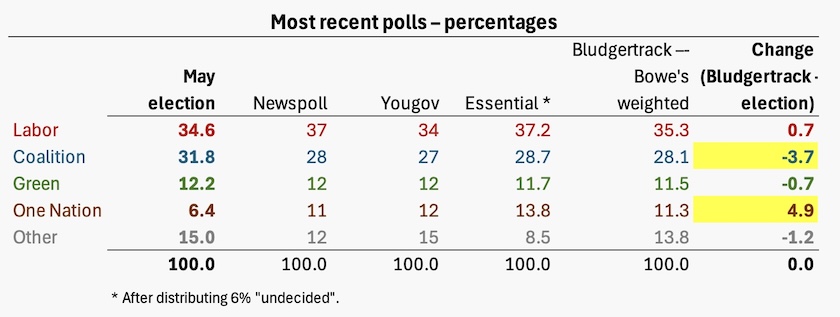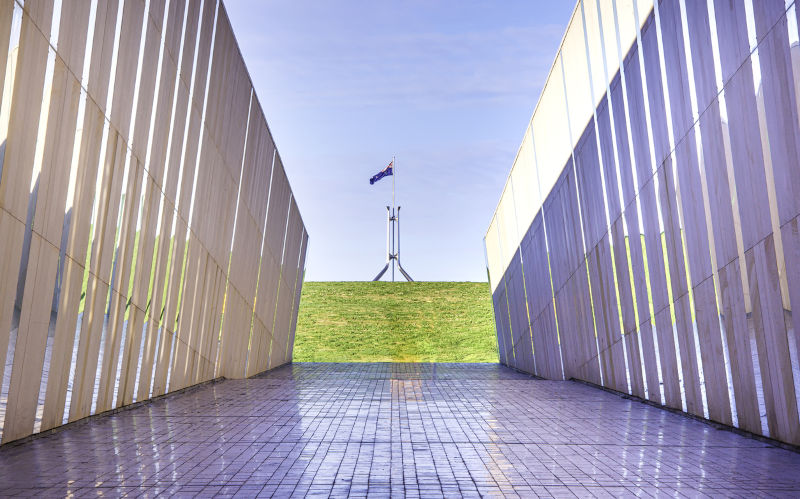How the Coalition’s right read the opinion polls
October 15, 2025
A superficial reading of the polls suggests the Liberal Party should move to the Trumpian right. This is a stupid and dangerous idea.
Political opinion polls conducted over late September to early October suggest there has been a surge in support for One Nation.
Opinion polls at this stage in the political cycle don’t tell us much about the likely outcome of the next election, but they do seem to explain some of the tensions within the Coalition.
William Bowe’s Poll Bludger reports on three polls conducted in that period – Newspoll, You Gov, and Essential. When three different polls tell much the same story, it’s a fair guess that any movements they reveal are more than reflections of sampling errors.
For Labor, the general story is that it has consolidated its support after the election, both primary support (shown in the table below) and in two-party preferred terms. That’s hardly surprising for a re-elected government.
The story for the Coalition is different. It seems to have bled support to One Nation. In round numbers it’s lost 4% support, while One Nation has picked up 5%. Part of One Nation’s gain may have come from Palmer’s Trumpets of Patriots and from other small parties who may not get picked up in the polls. But it does appear that the Coalition has lost support to parties on the right, because Labor isn’t picking it up, and there is no surge in support for the “others” not separately identified in the polls.
These poll results are shown in the table below, with significant movements highlighted.

This has probably led to some in the Coalition suggesting it should move to the right to stop that support from bleeding. Another framing of that perspective is that it has lost support because the Liberal Party has positioned itself too far to the “left”.
We are witnessing in the Coalition what is known to statisticians as “survivor bias”, the survivors in this case being the 43 Coalition members of the House of Representatives who kept their seats, of whom 34 represent conservative “provincial” or “rural” electorates to use the AEC terminology. See the table below.

Those 34 survivors are probably very aware of the threat from the far right, not just One Nation, but also from others towards that end of the spectrum. The table below shows how that support relates to AEC regional classification. In short, the surviving Coalition MPs represent hard-right electorates. It would be surprising if that did not influence their views on their parties’ prospects.

This far right presence is particularly noticeable in the 16 seats the LNP holds in Queensland. In those seats, One Nation won 9.8% of the primary vote, the Trumpets 3.7% and Family First 2.9%, taking the far right vote up to 16.4%. No wonder those 16 MPs feel wedged. As does Andrew Hastie, whose own electorate in south-west Western Australia has many of the same characteristics, as pointed out in last week’s round-up. One Nation won 11.4% of the vote in his Canning electorate – providing enough preferences to get him over the line from his 43.4% primary votes.
Writing in The Saturday Paper, John Hewson warns Hastie against “riding the anti-immigration wave” and taking other populist stances. Michael Taylor writes in The Australian Independent Media Network that Hastie’s ascent would be a gift for Labor. Although Hewson’s article is specifically addressed to Hastie, it’s a warning to the right of the Liberal Party generally.
A normal response to survivor bias would be for the Coalition parties, particularly the Liberal Party, to become less reliant on its Parliamentary caucus for developing policy, but it appears that its branches in at least three states are even more to the right than its caucus. In South Australia, where an election is due next March, the Australian affiliate of Charlie Kirk’s Turning Point is actively trying to shape the Liberal Party’s campaign.
It’s a tough and lonely time for the remaining grown-ups in the Liberal Party who want to take the party back towards the political centre – to the days when it could accommodate people like Hewson and John Gorton. Some must surely be considering the possibility of reconstituting the party and starting again, accepting that the Coalition is finished and that a new centre-right party has to stand on its own, separate from the National Party.
Republished from Bear Weekly Round up, 11 October 2025
The views expressed in this article may or may not reflect those of Pearls and Irritations.

